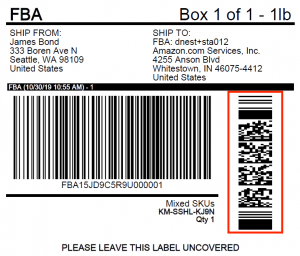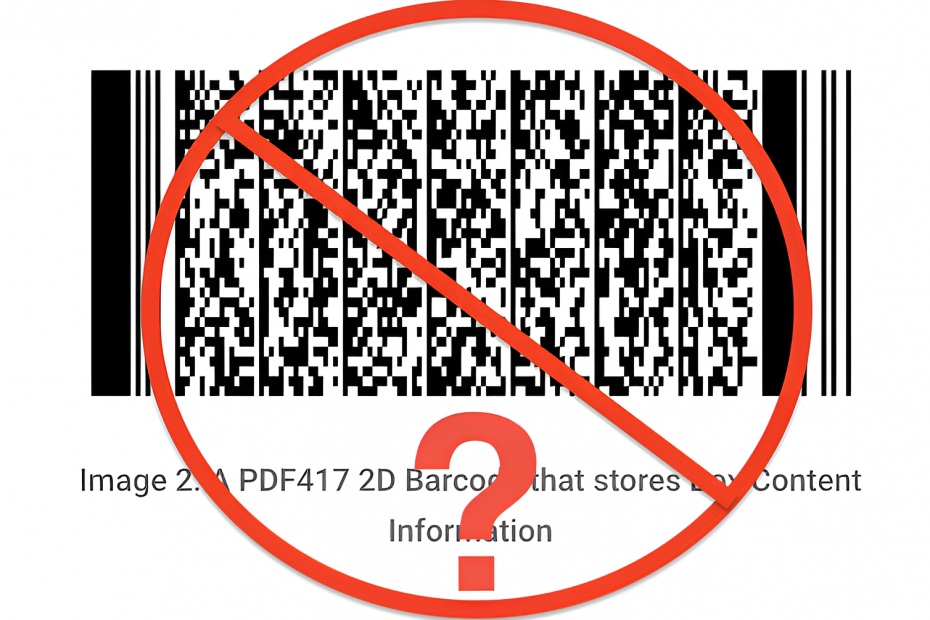In the past year or so, “2D Barcodes” have gotten a lot of hype for a variety of operational reasons. With that said, unfortunately, there is a lot of misinformation on their function, use, benefits, and their disadvantages.
What is a 2D Barcode?
A 2D barcode is a barcode that stores data in 2 dimensions — Horizontally and Vertically. Unlike UPCs or EANs, that only store data horizontally, 2D barcodes can store significantly more data in the same amount of space.
Amazon uses 2D barcodes in 2 main ways – On the Amazon Shipping Label (Image 1) and as an option for providing Box Content Information (Image 2). Examples Below.


What are the purposes of these labels?
Amazon Shipping Label
Amazon Requires all boxes to FBA to have an “Amazon Shipping Label” (Image 1). Without this shipping label, there can be delays with receiving your shipment and possible fees/suspension of your FBA Shipment privileges. This label tells which Box Number and FBA shipment the products are associated with. Articles and help pages indicating this 1D or 2D barcode (Both of these yield the same data) help speed up check-in times are accurate because they are critical to the identification of which Box and Shipment ID are being referenced for the units in that box.
Box Content Label(s)
The second barcode is a 2D Barcode that encodes, within the data matrix, what items are in the box. While Amazon does have services that will do your Box Content information for you, the information telling Amazon what is in each box, those services can be quite expensive. Plus Amazon has stated¹ 2D Barcodes for Box Contents may slow down check-in times. The alternative is uploading the Box Content information to Amazon via Webform, Excel or Tab Delimited file upload, “Send to Amazon” Workflow, or using “Everything in One Box” function.
Amazon also created an additional option for sellers who need other companies or personnel to create box contents without account access and those are in the form of storing content data in an additional 2D barcode (Image 2).
2D Barcodes -- The 3 Key Flaws
- 2D Barcodes for Box Contents were designed by Amazon as an alternative — Not the ideal form of Box Contents. If Amazon prioritized them, they would have a Seller Central interface for them, but instead, they state: “Please note that you will need to use a third-party application or website to generate 2D barcodes.”² If you truly need to use them, you must buy, build, or figure out software or a way to create these barcodes.
- Secondly, Amazon blatantly states that 2D Barcode Box Contents slow down check-in times according to their 2D Barcode Box Content Information help page: “Important: The use of 2D barcodes may cause delays in receiving your shipment. Shipments with 2D barcodes require more processing time than shipments with [Uploaded] box content information.”²
Because this method does not tell Amazon box contents of a box until they physically scan the barcode in the warehouse, Amazon prefers, based on their documentation and language, methods of box content information they can analyze and process before it arrives at the fulfillment or sortation center(s).
- Lastly, when using exclusively 2D Barcodes for box content, there is no “check” system for products needing expiration dates. Often there are items that require expiration dates that don’t actually expire, which can likely be missed in the packing process. If you miss them, Amazon states: “Failure to specify the manufacturing date or expiration date on a product might cause delays in receiving your products, or it may cause products to be received as expired at the fulfillment center.”³ By uploading Box Contents to Amazon, you will get errors that prevent you from completing the shipment if you miss them — allowing you to resolve them before shipping.
Myths vs Reality
When you upload feed (Through MWS/SP-API/Software or through the webform, upload spreadsheet, or in the various Seller Central interfaces), you tell Amazon “Box 1, a part of shipment ABC, contains one product of D, E, and F each” (Contents irrelevant for this discussion). Now when Amazon scans either barcode in image 1 above, that ID “FBA15JD9C5R9U000001” (FBA ID + U + Box number) will scan into their software and reference the data in their database that you submitted before shipping to see what’s in each box. This makes storing box content data in a 2D barcode on the box unnecessary.
A common misconception is that 2D barcodes will speed up check-in times (contradicting Amazon’s documentation), but is likely based on correlation; Not causation. 2D Barcodes are not what tells Amazon to unload a truck faster, but instead if that carrier has a “Dead Load” versus a “Live Load”. Both Partnered and Non-Partnered Carriers can have “Dead Load” shipments delivered to Amazon, which means they can drop off the trailer and Amazon can get to it whenever they’d like. Live Load shipments mean they have to be unloaded into the fulfillment center before the driver can leave, which speeds up check-in times.
Additionally, prioritization queues are a dynamic cycle at all Amazon fulfillment centers. A prioritization queue cannot tell the box contents of a shipment if the data isn’t uploaded to Amazon and a live load will have different prioritization than a dead load as they can wait till less-than-peak times to unload a dropped trailer. A full article explaining this concept can be made if there is enough interest.
When SHOULD you use 2D Barcodes?
- 2D Barcodes are useful! They have their purpose. If you want suppliers to generate box contents for you without access to Amazon, they can do so with the right software.
- 2D Box Content Barcodes store lots of data. This can be used for internal tracking, warehouse management, and pre-packing boxes if you want to.
- Lastly, we upload all our client’s box content information to Amazon, ensuring expiration dates are uploaded and the fastest, optimal check-in times, but also print 2D barcodes on the same label in case there is a temporary error with Amazon’s feeds, MWS/SP-API, or other technical issues. For example, if the shipment is marked as “Shipped” prematurely and we don’t have time to open a case to change it back to worked. We can resort to using 2D barcodes as a backup. This happens in probably 0.1-0.2% of our shipments — Extremely rarely. They are a fantastic backup plan in the midst of a technical issue, but are never relied upon.
At the end of the day, this article is simply to inform you so you can make the best decision for your business. Our facility uses Scanpower, which facilitates sending virtual contents, 2D barcodes, or however you’d like across all our clients along with efficient workflow for processing large sku, variety, and complex shipments. If you have any questions about this topic, feel free to Contact Us!

Thanks.
Great article guys, well written and informative.
Interesting read that makes me want to explore the methods of box creation mentioned and experience the improvements.
Accidentally having products received as Expired worry’s me as we ship a lot of products with BB dates to FBA.
Count me as “interested”. I soak this inbound process stuff up!
“Additionally, prioritization queues are a dynamic cycle at all Amazon fulfillment centers. A prioritization queue cannot tell the box contents of a shipment if the data isn’t uploaded to Amazon and a live load will have different prioritization than a dead load as they can wait till less-than-peak times to unload a dropped trailer. A full article explaining this concept can be made if there is enough interest.”